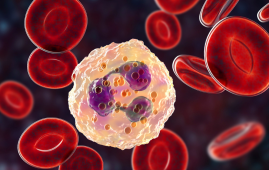

Adenosine deaminase 2 (ADA2) has emerged as a key regulator of immune function and reducing Autoimmune Disorders, influencing inflammation and monocyte differentiation through both lysosomal and extracellular mechanisms.
Recent research has underscored the critical role of adenosine deaminase 2 (ADA2) in Autoimmune Disorders, particularly within the context of autoimmune disorders. ADA2 influences inflammatory balance through both lysosomal activity and extracellular interactions, offering new insights into its potential as a therapeutic target in chronic inflammatory conditions, including systemic vasculitis. This dual role is drawing attention to its relevance in autoimmune disorders, chronic infections, and vascular inflammation, including systemic vasculitis.
Explore all Allergy and Immunology CME/CE Conferences 2025
ADA2’s Role in Inflammatory Modulation and Monocyte Differentiation
ADA2 operates through dual mechanisms. Within lysosomes, it participates in intracellular signaling and epigenetic regulation, particularly by modulating DNA methylation and TLR9 pathways. These epigenetic changes influence how monocytes and macrophages respond to immune stimuli, helping maintain immune homeostasis.
Extracellularly, ADA2 binds to apoptotic cells, aiding in their clearance without activating a full-scale inflammatory response. This function is crucial in preventing unnecessary immune activation, especially in settings of chronic infections or tissue injury. In this way, ADA2 helps balance immune activation and resolution, an essential factor in preventing the onset of autoimmune disorders.
Growth Factor Influence on ADA2 Expression
ADA2 expression is tightly regulated by growth factors such as GM-CSF and M-CSF, which direct monocyte differentiation into either pro-inflammatory M1 or anti-inflammatory M2 macrophages. This polarization determines whether the immune system perpetuates inflammation or promotes healing. ADA2 deficiency skews this balance, promoting elevated levels of pro-inflammatory cytokines like TNF-α, key markers in diseases such as systemic vasculitis and other autoimmune syndromes.
ADA2 as a Biomarker and Potential Therapeutic Target
Deficiency in ADA2, as seen in DADA2, is linked to early-onset strokes and vasculitis. While enzyme replacement therapy has been explored, challenges related to protein stability and distribution remain. Researchers are now investigating intracellular ADA2 modulation as a more targeted approach.
In addition, ADA2 levels in bodily fluids like bronchoalveolar lavage are being evaluated as biomarkers for immune status and disease progression, reinforcing its role in diagnostic strategies.
For More Information: Dong, L., et al. (2025). Intracellular concentration of ADA2 is a marker for monocyte differentiation and activation. Frontiers of Medicine. doi.org/10.1007/s11684-024-1110-6.
more recommended stories
 Silica Nanomatrix Boosts Dendritic Cell Cancer Therapy
Silica Nanomatrix Boosts Dendritic Cell Cancer TherapyKey Points Summary Researchers developed a.
 Vagus Nerve and Cardiac Aging: New Heart Study
Vagus Nerve and Cardiac Aging: New Heart StudyKey Takeaways for Healthcare Professionals Preserving.
 Cognitive Distraction From Conversation While Driving
Cognitive Distraction From Conversation While DrivingKey Takeaways (Quick Summary) Talking, not.
 Fat-Regulating Enzyme Offers New Target for Obesity
Fat-Regulating Enzyme Offers New Target for ObesityKey Highlights (Quick Summary) Researchers identified.
 Spatial Computing Explains How Brain Organizes Cognition
Spatial Computing Explains How Brain Organizes CognitionKey Takeaways (Quick Summary) MIT researchers.
 Gestational Diabetes Risk Identified by Blood Metabolites
Gestational Diabetes Risk Identified by Blood MetabolitesKey Takeaways (Quick Summary for Clinicians).
 Phage Therapy Study Reveals RNA-Based Infection Control
Phage Therapy Study Reveals RNA-Based Infection ControlKey Takeaways (Quick Summary) Researchers uncovered.
 Pelvic Floor Disorders: Treatable Yet Often Ignored
Pelvic Floor Disorders: Treatable Yet Often IgnoredKey Takeaways (Quick Summary) Pelvic floor.
 Urine-Based microRNA Aging Clock Predicts Biological Age
Urine-Based microRNA Aging Clock Predicts Biological AgeKey Takeaways (Quick Summary) Researchers developed.
 Circadian Control of Neutrophils in Myocardial Infarction
Circadian Control of Neutrophils in Myocardial InfarctionKey Takeaways for HCPs Neutrophil activity.

Leave a Comment